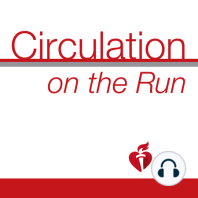23 min listen
Circulation April 17, 2018 Issue
ratings:
Length:
22 minutes
Released:
Apr 17, 2018
Format:
Podcast episode
Description
Dr Carolyn Lam: Welcome to Circulation on the Run, your weekly podcast summary and backstage pass to the journal and its editors. I'm Dr. Carolyn Lam, Associate Editor from the National Heart Center and Duke National University of Singapore. Does NT-proBNP-guided therapy improve outcomes in acute decompensated heart failure? Well the Prima II trial results are coming right up after these summaries. Is hospital volume a good structural metric assessing the quality of care in heart failure? Well, in the first original paper this week from Dr. Kumbhani and colleagues at UT Southwestern Medical Center, authors determined the relationship between admission volume, process of care metrics, and short and long-term outcomes admitted with acute heart failure in the Get With the Guidelines-Heart Failure registry, which has linked Medicare in patient data at 342 hospitals. They found that lower volume hospitals had worse adherence to important heart failure process measures, than higher volume hospitals. There was no association between risk adjusted in-hospital mortality and hospital heart failure admission volume among older adults. After adjusting for adherence with process measures at discharge, annual heart failure admission volume had a minimal association with mortality, and readmissions up to six months post-discharge. Thus, rather than focusing solely on hospital volume, hospital profiling efforts should perhaps focus more on participation in quality improvement initiatives, adherence to process metrics, and risk standardized outcomes. The next study describes the association between air pollution and heart disease mortality in the United States, with a focus on whether the association differs by race and ethnicity. First and corresponding author Dr. Jennifer Parker from the National Center of Health Statistics Centers of Disease Control and Prevention and her colleagues use data from the 1997 to 2009 National Health Interview Survey linked to mortality records through December 2011 and the Annual Estimates of Fine Particulate Matter or PM2.5 as an index of air pollution. They found that the association between air pollution and heart disease mortality in this national sample was elevated and similar to estimates found in prior studies. After controlling for social demographic and geographic factors, the associations between air pollution and heart disease mortality for non-Hispanic black and Hispanic adults were not statistically significantly different from that of non-Hispanic white adults. Thus, this study supports the application of findings from prior studies of air pollution and mortality, albeit largely from non-Hispanic white adults, but to other races and ethnicities in the United States. The next study suggests that large cardiac muscle patches engineered from human induced pluripotent stem cells may be a reality. First author Dr. Gao, corresponding author Dr. Zhang from University of Alabama at Birmingham generated human cardiac muscle patches of clinically relevant dimensions of 4 x 2 centimeters and they did that by suspending cardiomyocytes, smooth muscle cells, and endothelial cells that had been differentiated from human-induced pluripotent stem cells in a fibrin matrix and culturing this construct on a dynamic platform. The results from in vitro assessments of calcium transience, action potential propagation, and forced generation, as well as the presence of intercalated disc-like structures, suggested that cardiomyocytes matured in these human cardiac muscle patches. During the 7-day dynamic culture period. When transplanted onto infarcted swine heart, measurements of cardiac function, infarct size, wall stress all improved with no incr
Released:
Apr 17, 2018
Format:
Podcast episode
Titles in the series (100)
Circulation September 19, 2017 Issue: Circulation Weekly: Your Weekly Summary & Backstage Pass To The Journal by Circulation on the Run
